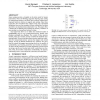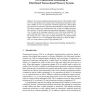122 search results - page 1 / 25 » Memory models for open-nested transactions |
ACMMSP
2006
ACM
13 years 11 months ago
2006
ACM
Open nesting provides a loophole in the strict model of atomic transactions. Moss and Hosking suggested adapting open nesting for transactional memory, and Moss and a group at Sta...
ASPLOS
2006
ACM
13 years 11 months ago
2006
ACM
Nested transactional memory (TM) facilitates software composition by letting one module invoke another without either knowing whether the other uses transactions. Closed nested tr...
PPOPP
2009
ACM
14 years 5 months ago
2009
ACM
Researchers in transactional memory (TM) have proposed open nesting as a methodology for increasing the concurrency of transactional programs. The idea is to ignore "low-leve...
SSS
2010
Springer
13 years 3 months ago
2010
Springer
We present a distributed transactional memory (TM) scheduler called Bi-interval that optimizes the execution order of transactional operations to minimize conflicts. Bi-interval c...
WDAG
2010
Springer
13 years 3 months ago
2010
Springer
We argue that traditional synchronization objects, such as locks, conditions, and atomic/volatile variables, should be defined in terms of transactions, rather than the other way ...



